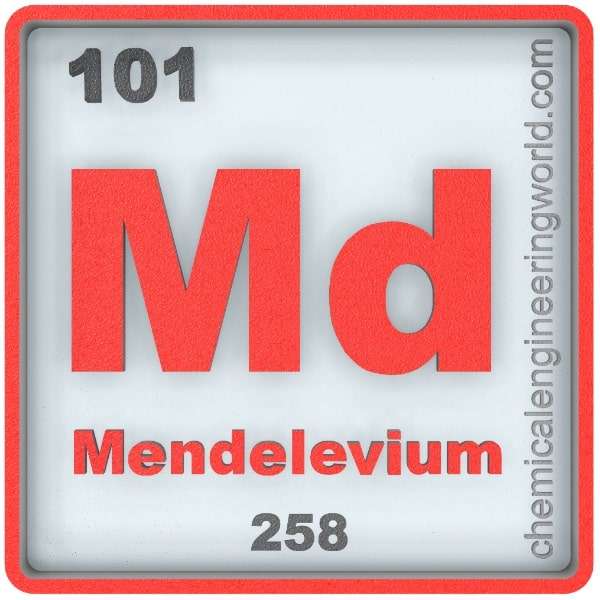Mendelevium Element Properties and Information

Mendelevium Element Properties and Information
Mendelevium is 101st element on the periodic table. Elements are arranged in the periodic table on the basis of the atomic number. Atomic number is the number of protons in the nucleus of the atom. Mendelevium has an atomic number of 101. It is located in the Group ‘Actinides’ and Period 7 of the periodic table of elements and denoted by the symbol ‘Md’. Mendelevium is named after Dimitri Mendeleev, the father of the periodic table. Albert Ghiorso, Bernard Harvey, Gregory Chopin, Stanley Thompson, and Glenn Seaborg bombarded einsteinium-253 with alpha particles in a cyclotron and observed a new element in 1955. They were able to collect 17 elements of mendelevium-256 in that experiment, it was the first ever element to be synthesised one atom at a time. Further experiments yielded several thousands of atoms of mendelevium and today it is possible to make millions of atoms.
Physical Properties
- Mendelevium is an actinide metal which has yet not been prepared in bulk quantities because bulk preparation is currently impossible.
- The atomic mass of mendelevium is (258).
- The melting point of mendelevium is predicted to be 827°C.
- The boiling point of mendelevium is unknown as of yet.
- The density of mendelevium is predicted to be around 10300 in S.I. units at 20°C.
- Theoretical properties such as atomic radius have been confirmed with trace quantity experimentation.
- Mendelevium is assumed to possess a face-centered cubic crystal structure.
- Nearly 17 isotopes of mendelevium have been characterised so far.
Chemical Properties
- Mendelevium chemistry has been studied only for solutions as of yet.
- Mendelevium solution compounds are observed have oxidation states of +2 and +3. The +1 oxidation state is theoretically predicted but not confirmed.
- Mendelevium forms coordination compounds with DCTA.
- Mendelevium(III) is easily reducible to mendelevium(II).
Methods of Production
Particle Accelerator: All the elements which have atomic number greater than 100 can only be prepared through reactions in a particle accelerator such as a cyclotron; they are not formed in a nuclear reactor. The lightest mendelevium isotopes, mendelevium-244 to mendelevium-247, are produced through bombardment of bismuth targets with heavy argon ions. The slightly heavier mendelevium isotopes, mendelevium-248 to mendelevium-253, are produced through bombardment of plutonium and americium targets with lighter ions of carbon and nitrogen. Most important mendelevium isotopes, mendelevium-254 to mendelevium-256, are produced through bombardment of einsteinium-253, einsteinium-254, and einsteinium-255 with alpha particles. Mendelevium-259 is produced as a daughter of nobelium-259. Mendelevium-260 is produced during a transfer reaction between einsteinium-254 and oxygen-18.
Relevance in Chemical & Related Industries
Mendelevium has no relevant use in chemical & related industries.
Relevance in Other Industries
Research: Mendelevium has relevance only in the field of research.
Health Effects on Exposure
Mendelevium does not occur naturally hence there is no reason to study its effects on health.
Effects on Exposure
Mendelevium does not occur in Earth’s crust hence there is no reason to study its effects on environment.
References:
https://en.wikipedia.org/wiki/Mendelevium
https://www.lenntech.com/periodic/elements/md.htm
https://www.rsc.org/periodic-table/element/101/mendelevium
































